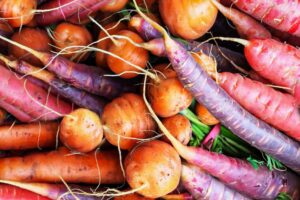Back to: Pre Vocational Studies JSS 1
Welcome to class!
In today’s class, we’re going to be talking about the uses of crop. I trust you will enjoy the class!
Introduction
Crop plants are the foundation of human civilization, providing us with food, fiber, medicine, and other essential resources. They have been cultivated for thousands of years and continue to play a vital role in our lives. Let’s explore the diverse uses of crop plants.
Uses of Crop Plants
For Food

- Staple Foods: Crops like rice, maize, wheat, cassava, and yam are the primary sources of carbohydrates and energy for billions of people worldwide. These staples are essential for providing a balanced diet and ensuring food security.
- Vegetables and Fruits: A wide variety of vegetables and fruits, such as tomatoes, potatoes, carrots, apples, oranges, and bananas, provide essential vitamins, minerals, and antioxidants. These nutrient-rich foods are crucial for maintaining good health and preventing diseases.
- Legumes: Beans, peas, and lentils are excellent sources of protein, fiber, and iron. They are often used in vegetarian and vegan diets as a plant-based alternative to meat.
- Grains: Grains like barley, oats, and millet are used to make bread, pasta, cereals, and alcoholic beverages. They are a versatile ingredient in many cuisines and are a good source of carbohydrates and fiber.
- Oilseeds: Crops like soybeans, sunflowers, and palm oil are processed to extract edible oils for cooking and other uses. These oils are essential for adding flavor and nutrients to food.
For Fiber
- Textiles: Cotton, flax, hemp, and jute are used to produce textiles, clothing, and other products. These natural fibers are breathable, durable, and often preferred over synthetic materials.
- Paper: Wood from trees is a major raw material for the paper and pulp industry. Paper is essential for communication, education, and record-keeping.
- Ropes and Twine: Fibers from plants like sisal and jute are used to make ropes, twine, and other cordage. These materials are used in various industries, including construction, agriculture, and shipping.
For Medicine

- Herbal Remedies: Many plants contain medicinal properties and are used to treat various ailments. Examples include ginger, turmeric, aloe vera, and echinacea. These natural remedies have been used for centuries and are often effective in treating common health conditions.
- Pharmaceutical Drugs: Some drugs are derived from plant compounds, such as aspirin from willow bark and morphine from opium poppies. These drugs have revolutionized modern medicine and have saved countless lives.
Industrial Uses

- Biofuels: Crops like sugarcane, palm oil, and jatropha can be processed into biofuels, reducing dependence on fossil fuels. Biofuels are a renewable energy source that can help mitigate climate change.
- Bioplastics: Plant-based materials can be used to produce biodegradable plastics, reducing environmental pollution. Bioplastics are a sustainable alternative to traditional plastic products that break down naturally and do not harm the environment.
- Building Materials: Bamboo, cork, and wood are used in construction for building materials, furniture, and other products. These natural materials are durable, renewable, and often have better insulation properties than synthetic materials.
Ornamental Plants
- Flowers: Flowers are cultivated for their beauty and used in bouquets, gardens, and landscaping. They add color, fragrance, and joy to our lives.
- Houseplants: Many plants are grown indoors for their ornamental value and air-purifying properties. Houseplants can improve indoor air quality, reduce stress, and create a more pleasant living environment.
Cultural Significance
- Religious and Rituals: Certain plants have cultural significance in various religions and rituals. They are often used in religious ceremonies, festivals, and celebrations.
- Art and Literature: Plants have inspired artists and writers throughout history. They have been depicted in paintings, sculptures, poetry, and literature, reflecting their beauty and cultural importance.
Summary
Crop plants are essential for human survival and well-being. They provide us with food, fiber, medicine, and industrial materials. By understanding the diverse uses of crop plants, we can appreciate their importance and the need for sustainable agricultural practices.
Evaluation:
- What are the main uses of crop plants?
- What are the benefits of growing organic crops?
- How can we improve crop yields?
We have come to the end of today’s class. I hope you enjoyed the class!
In case you require further assistance or have any questions, feel free to ask in the comment section below, and trust us to respond as soon as possible. Great job so far and see you in the next class!
